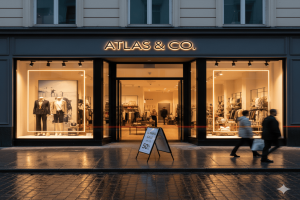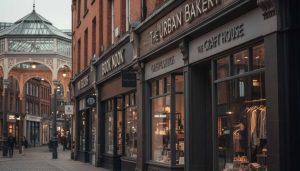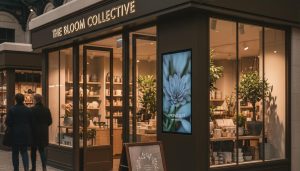In today’s hyper-competitive retail landscape, customers are overwhelmed with choices. Whether they shop in malls, high streets, or boutique stores, they are constantly influenced—often subconsciously—by the visual cues around them. One of the most powerful tools that influences buying behaviour is retail signage, including exterior storefront signage and the indoor retail signs they encounter once inside.
Far from being just “decor” or “labels,” modern retail signage acts as a strategic communication system. It directs customers, highlights products, boosts brand awareness, drives impulse buys, and shapes the entire in-store experience. Whether a retailer aims to generate higher foot traffic, increase conversion rates, or simply deliver a seamless shopping journey, the right signage system is essential — from visual merchandising signs to promotional signage displays and newer digital signage solutions.
This guide breaks down the full spectrum of retail signage types, how they work, when to use them, and how they contribute to brand success. If you’re looking for a complete, in-depth and human-focused guide — this is it.
What Is Retail Signage?
Retail signage refers to any visual graphic display used within or outside a retail space to communicate messages to customers. This includes signs that:
- advertise
- inform
- direct
- guide
- persuade
From outdoor storefront signage to in-aisle shelf signage for stores, signage shapes a shopper’s perception before they even enter the store. In many ways, retail signage functions as an in-store salesperson: always present, always communicating, and always influencing behaviour.
Beyond simple messaging, signage plays a key role in brand identity. Colours, fonts, layouts, and materials all contribute to how a store is perceived—whether premium, playful, minimalistic, or budget-friendly. Good signage not only tells a customer where to go but also gives them a sense of what the brand stands for through well-executed visual merchandising signs.
Effective signage must be visually appealing, strategically placed, and aligned with both branding and the customer journey. When done correctly, it improves navigation, reduces confusion, increases dwell time, and can significantly boost sales by drawing attention to products customers may have otherwise overlooked — especially when enhanced with indoor retail signs or promotional signage displays.
Why Retail Signage Is Crucial for Retail Success
In a retail environment where customers make decisions within seconds, retail signage acts as one of the most influential tools a business can rely on. It shapes how shoppers perceive the brand, how easily they move through the store, and how confidently they make purchasing decisions. Strong signage doesn’t just decorate a space — it drives behaviour, creates atmosphere, and directly impacts sales performance. When used strategically, it becomes an essential part of a retailer’s marketing, branding, and operational toolkit.
Enhances Brand Identity
Brand identity is more than a logo — it’s an experience. Consistent, well-designed retail signage — from storefront signage to interior visual merchandising signs — reinforces who you are as a business. Customers associate visual cues with quality, trust, and style. A store with premium, polished signage instantly communicates professionalism, whereas poor signage can undermine credibility.
Drives Sales and Conversion
Numerous studies show that clear signage can increase impulse purchases and product visibility. Without effective retail signage, many products remain overlooked. Good signs draw attention, explain value, and push customers toward action — especially well-placed promotional signage displays and shelf signage for stores.
Improves Customer Experience
People want effortless navigation. Confusing store layouts frustrate shoppers and reduce the time they spend browsing. Retailers who invest in wayfinding signage UK and informational indoor retail signs create a smoother, more enjoyable experience — which directly boosts sales.
Reduces Staff Workload
Customers can answer many of their own questions through proper signage — pricing, directions, product details, promotions, and more. This frees up staff to focus on higher-value interactions.
Main Types of Retail Signage
Retailers rely on a wide variety of signage to attract, inform, and guide customers. Each type plays a specific role in shaping the in-store journey, building trust, and encouraging purchases. Below is an in-depth look at the major categories of retail signage, how they function, and where they are most effective.
Outdoor Retail Signage
Outdoor signage is the first interaction a potential customer has with a store. It determines whether a person walks inside—or keeps walking. The right exterior signs enhance visibility, strengthen brand identity, and increase foot traffic.
Storefront Signs
Storefront signs are positioned above entrances and display the store name, logo, and brand style. They:
- increase visibility from a distance
- create instant brand recognition
- influence first impressions
- attract passing shoppers
Because customers often judge a business by its exterior, storefront signage should be bold, well-designed, weather-resistant, and ideally illuminated for evening visibility.
Window Displays
Window graphics combine visual creativity with promotional messaging. It’s one of the most powerful marketing tools for drawing customers inside. Retailers use it to showcase:
- new arrivals
- holiday or seasonal themes
- product launches
- exclusive promotions
When paired with well-crafted visual merchandising signs, window retail signage can trigger impulse visits and boost walk-in conversions dramatically.
Pavement & A-Frame Signs
Placed on pavements or outside entrances, A-frame signs capture the attention of pedestrians. They are especially effective for cafés, boutiques, salons, pop-up stores, and neighbourhood shops. These signs are perfect for promoting:
- daily specials
- flash sales
- limited-time deals
- menu items or offers
Their portability makes them easy to update and reposition, allowing retailers to respond quickly to changing foot traffic.
Indoor Retail Signage
Once customers step inside, indoor retail signs take over — helping them navigate, discover products, and make confident decisions.
Wayfinding Signs
Wayfinding retail signage provides clear direction throughout the store. Examples include:
- aisle markers
- overhead department signs
- floor arrows
- entrance/exit markers
Effective wayfinding reduces confusion, improves flow, and encourages shoppers to explore more of the store.
Informational Signs
Informational signs deliver details customers need before making a purchase. These might include:
- product specifications
- pricing
- care and usage instructions
- ingredient lists
- sustainability or ethical details
Clear, well-placed informational retail signage reduces hesitation and supports more informed buying decisions.
Category & Department Signs
Category signage helps customers find what they’re looking for quickly. Examples include:
- “Menswear”
- “Groceries”
- “Home & Living”
- “Electronics”
These signs are essential in supermarkets, department stores, and large retail spaces where navigation can otherwise be overwhelming.
Shelf Talkers & Shelf-Edge Labels
These small but highly influential signs attach directly to shelves. They highlight:
- discounts
- product benefits
- comparisons
- new arrivals
- staff picks
Shelf-edge retail signage often provides the final push that convinces a shopper to choose one product over another.
Promotional Retail Signage
Promotional signage focuses on driving sales, creating urgency, and boosting conversions.
Sale Signs
Bold sale signage grabs attention instantly. High-contrast colours are often used to communicate urgency. Retailers display sale signs during:
- clearance events
- seasonal sales
- Black Friday
- Boxing Day
- promotional campaigns
Effective promotional retail signage increases foot traffic and accelerates purchase decisions.
Point-of-Sale (POS) Displays
Positioned near tills or checkout counters, POS displays encourage impulse buying. They typically showcase:
- snacks
- accessories
- beauty minis
- gift cards
- seasonal items
Shoppers at checkout are already in a buying mindset, making POS signage an effective final upsell tool.
Endcap Displays
Endcaps sit at the end of aisles—the highest-visibility areas in most stores. Brands use endcap retail signage to promote:
- new product launches
- best sellers
- limited-time deals
- themed collections
These displays perform well because shoppers naturally slow down at aisle ends.
Digital Retail Signage
Digital signage is transforming the modern retail experience, offering dynamic, interactive, and highly engaging communication.
Digital Screens
Digital screens display rotating content such as:
- video ads
- promotional animations
- brand storytelling
- product features
Digital retail signage is effective because it captures attention quickly, updates instantly, and elevates the overall in-store atmosphere.
Interactive Kiosks
Touchscreen kiosks empower customers to:
- search for products
- check stock
- compare items
- place orders
- browse catalogues
By blending digital and physical shopping, interactive retail signage enhances convenience and improves customer satisfaction.
Video Walls
Video walls consist of multiple screens working together to create immersive visual experiences. They are common in:
- luxury fashion
- technology stores
- large retail showrooms
Video walls excel at storytelling, brand reinforcement, and capturing attention from a distance.
Specialty Retail Signage
These unique signage types add personality, ambience, and creativity to a store.
Neon & LED Signs
Neon and LED signs offer:
- striking visual appeal
- atmospheric lighting
- strong brand identity
- Instagram-friendly aesthetics
They are especially popular in fashion stores, bars, beauty salons, and lifestyle brands.
Floor Graphics
Floor graphics are used for both practical and promotional purposes. They help:
- guide customers
- mark pathways
- promote offers
- communicate safety information
- manage queues
Floor retail signage is also useful for events, launches, and store-wide campaigns.
Hanging Signs & Banners
Suspended signs and banners are highly visible from afar, making them valuable in large or multi-level retail environments such as:
- supermarkets
- homeware stores
- warehouses
They help define spaces, highlight key sections, and improve overall store navigation.
How to Choose the Right Retail Signage for Your Store
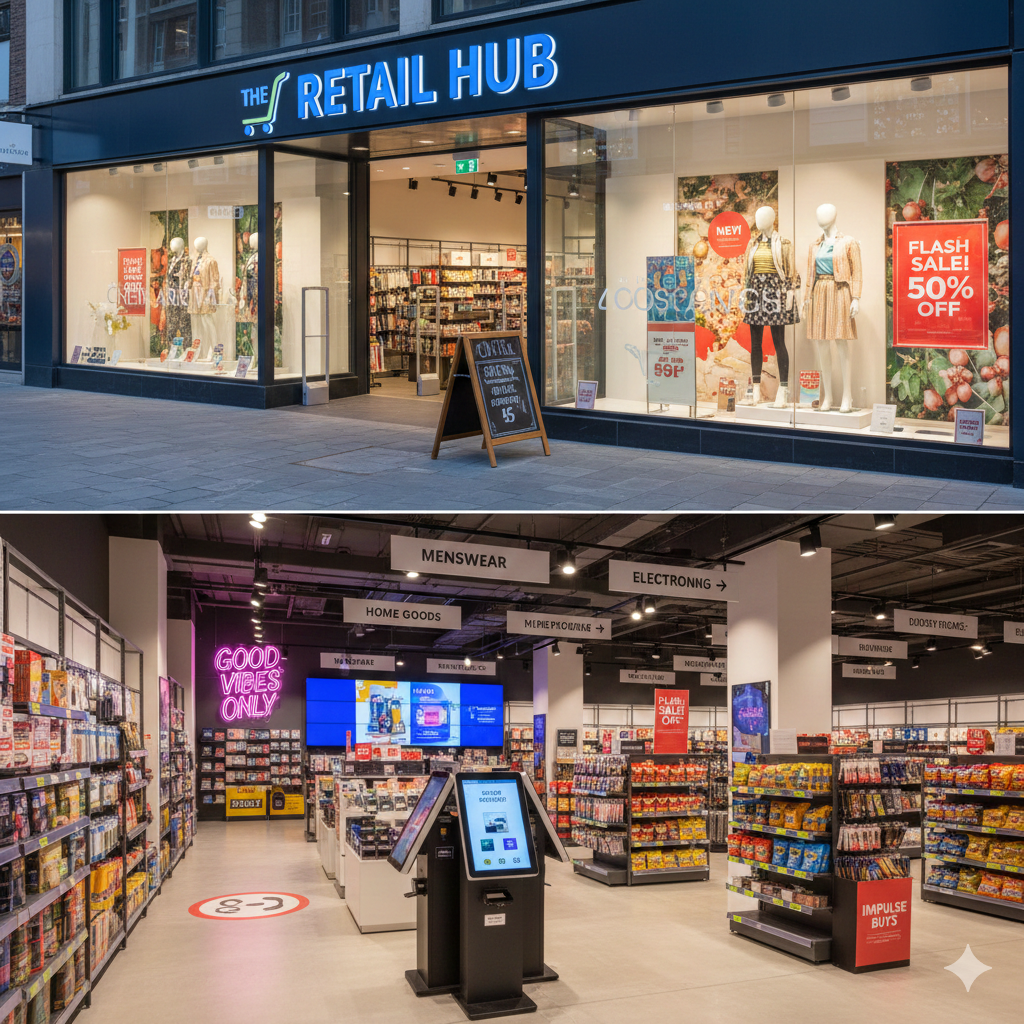
Choosing the right retail signage isn’t about picking a design you “like.” It’s a strategic process that combines customer psychology, brand identity, store layout, and communication clarity. When done correctly, signage becomes a powerful, silent salesperson that guides shoppers effortlessly and influences their buying decisions.
Below is a practical, structured approach to choosing the best signage for your space.
Understand Your Customer Journey
Before deciding what signs you need, map out exactly how customers behave in your store.
Questions to Analyse
- Where do customers naturally pause?
- Which areas feel confusing or cause hesitation?
- Where do key buying decisions typically occur?
- Which products tend to be overlooked?
- Where do customers frequently ask staff for help?
Why This Matters
Your signage becomes far more effective when it’s placed at strategic touchpoints such as:
- Entry points (first impressions influence shopping mood)
- Transition zones (shoppers adjust mentally as they move through departments)
- Decision zones (areas where comparison or evaluation happens)
- Checkout zones (ideal for impulse products and last-minute promotions)
By aligning signage with behavioural patterns, you’re meeting customers exactly where their attention is highest.
Define Your Brand Voice
Your retail signage should speak in the same “voice” your brand uses everywhere else. Think of signage as part of your brand personality — it should feel instantly recognisable.
Elements That Shape Your Brand Voice
- Colour palette
Soft neutrals for luxury, bold hues for youth-focused brands, eco tones for sustainable retailers. - Typography
Elegant serif fonts suggest premium quality; rounded sans-serifs feel friendly and modern. - Tone of messaging
- Playful (“Grab it before someone else does!”)
- Minimal (“Essentials. Redefined.”)
- Premium (“Crafted with precision.”)
- Playful (“Grab it before someone else does!”)
Why Consistency Matters
Consistent signage helps customers quickly understand:
- Who you are
- What you stand for
- What experience they can expect
A mismatch (e.g., luxury store with loud, neon sale posters) can confuse customers and weaken brand integrity.
Prioritise Readability
At its core, retail signage is communication — and communication fails if customers can’t read it quickly.
Readability Principles
- Keep text minimal
Aim for 3–7 words per sign whenever possible. - Use a clear visual hierarchy
- Headline — largest and boldest
- Subheading — smaller, supportive
- Body text — only when essential
- Headline — largest and boldest
- Ensure visibility
Signs should be readable from the appropriate viewing distance. - Avoid clutter
White space improves comprehension and draws attention to the message.
Quick Readability Test
If a customer can’t understand the sign’s purpose within three seconds, it’s too complicated.
Consider Materials & Durability
Different retail environments require different materials. Choosing incorrectly can lead to short lifespans, fading, or safety issues.
Outdoor Signage Needs
- Weather-resistant materials (aluminium, acrylic, dibond)
- UV-resistant inks to prevent fading
- Sturdy installation to withstand wind and temperature changes
- Waterproof LED systems for illuminated signs
Indoor Signage Needs
- Scuff-resistant surfaces for high-traffic zones
- Lightweight materials for safe hanging
- Non-reflective finishes to reduce glare
- Durable prints for long-term usage
Digital Signage Considerations
- Does your team have resources to update content regularly?
- Will the screen brightness be sufficient in a bright store?
- Is interactivity needed (touchscreens, product finders)?
- Are you prepared for software updates and media scheduling?
Digital signage is powerful — but only if maintained consistently.
Best Practices for Effective Retail Signage
Once you’ve selected the right signage type, it’s crucial to follow best practices that maximise impact.
Keep the Message Short and Clear
Customers don’t read paragraphs while shopping. They skim.
Your signage should deliver value instantly.
Strong messaging examples:
- “New In”
- “Buy 1 Get 1 Free”
- “Top Seller”
- “Organic Alternatives Available”
Use High-Quality Images & Graphics
Poor quality visuals can harm brand perception instantly.
What to Use
- High-resolution product photos
- Professional lifestyle imagery
- Clean vector icons and illustrations
What to Avoid
- Pixelated graphics
- Overly busy backgrounds
- Clipart-style visuals
High-quality visuals help establish credibility and attract attention.
Maintain Consistency Across All Signs
Consistency builds trust and avoids visual chaos.
Elements That Must Stay Consistent
- Colours
- Fonts
- Logo usage
- Graphic style
- Messaging tone
When signage varies too much, customers feel visually overwhelmed, which reduces engagement.
Update Signage Regularly
Stale signage makes a store feel forgotten and outdated.
Update Triggers
- New product launches
- Seasonal promotions
- Price changes
- Brand refreshes
- Stock changes
Fresh signage shows customers that the store is active and well-maintained.
Use Colour Contrast Effectively
Contrast is one of the biggest factors in readability.
Strong Contrast Examples
- Dark text on a light background
- White text on bold colours
- High-contrast colour pairs like black/yellow or navy/white
Avoid Low-Contrast Combinations
- Light grey on white
- Pale blue on beige
- Yellow on light green
Contrast determines whether customers notice your sign or walk right past it.
Retail Signage Design Principles
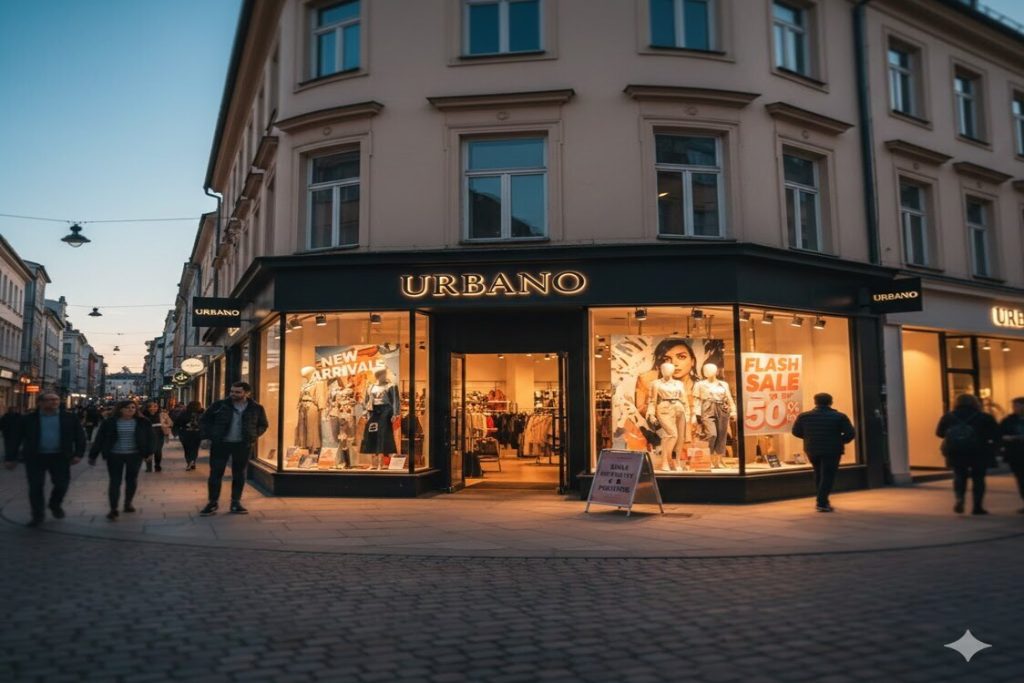
Effective retail signage is built on more than good design — it is grounded in a set of strategic principles that determine how shoppers see, read, and respond to visual cues. Signage must communicate quickly, guide customers intuitively, and reinforce brand identity, all while blending seamlessly into the store environment. When done right, signage feels natural, helpful, and persuasive rather than distracting or overwhelming. Below are the core principles that shape high-performing retail signage.
1. Clarity Above Everything
The number one rule is simple: the message must be instantly understood. Retail signage has only seconds to capture attention, so the language should be short, sharp, and uncomplicated. Customers should understand the message without re-reading. Clear messaging reduces friction and helps shoppers take action — whether that’s discovering a product, moving toward a section, or responding to a promotion.
2. Use Purposeful Colour & Strong Contrast
Colour is one of the most influential elements in visual communication. It sets tone, attracts attention, and enhances readability. Good signage design uses colours that align with the brand while delivering strong contrast between text and background. High contrast increases visibility from a distance and supports accessibility for visually impaired shoppers. Accent colours can be introduced strategically to highlight promotions, callouts, or directions without cluttering the design.
3. Choose Legible, Brand-Appropriate Typography
Typography carries both functional and emotional weight. The font should reflect the brand personality yet remain easy to read from different distances. Sans-serif fonts are typically best for fast scanning, while serif fonts can add a sense of sophistication when used sparingly. Hierarchy is critical: headlines should be bold and dominant, secondary text smaller, and details even lighter. A clear hierarchy guides the eye naturally and helps customers prioritise information.
4. Create Thoughtful Visual Hierarchy
Every sign needs a defined focal point. The most important message — whether it’s “SALE,” “New Arrivals,” or “Clearance” — should be the first thing shoppers notice. Supporting details (percentages, dates, product benefits) should appear beneath or around it. A strong hierarchy ensures customers grasp the essential message instantly, even while walking by.
5. Embrace White Space & Balanced Layouts
White space, or negative space, is not “empty”; it is essential breathing room. It keeps the design open, modern, and easy on the eyes. Crowded signage feels cheap and confuses the viewer. Balanced layouts with adequate spacing improve comprehension and elevate the overall retail experience.
The Future of Retail Signage
Retail signage is evolving rapidly with modern technology — but physical signs still remain essential.
Emerging Trends
- Digital retail signage that updates instantly across multiple stores
- AI-driven recommendations based on browsing behaviour or weather
- Interactive touchscreens for product details and navigation
- Augmented reality (AR) for virtual try-ons or in-store guides
- Personalised content triggered by proximity sensors or mobile apps
Why Traditional Signage Still Matters
Despite technological advancements, physical signage offers:
- Immediate visibility
- Low maintenance
- Cost-effectiveness
- High emotional impact
- Tangible presence that digital screens can’t replicate
Both digital and traditional signage now work hand-in-hand to create a richer, modern customer experience.
Common Retail Signage Mistakes to Avoid
Even with good intentions, many retailers fall into common signage mistakes that weaken communication and harm the customer experience. Understanding these pitfalls helps ensure your signage system remains effective, modern, and aligned with your brand. Below are the most frequent errors — and why they matter.
1. Overloading Signs With Too Much Text
One of the biggest signage mistakes is trying to say too much. Long paragraphs or crowded messages lead to visual fatigue. Shoppers won’t stop to read signs that look intimidating or cluttered. When customers can’t instantly understand a message, they ignore it entirely. Signage should guide, not overwhelm — and clear, concise language always outperforms lengthy explanations.
2. Poor Visibility Due to Low Contrast
Low-contrast colour combinations — like yellow on white or light grey on beige — drastically reduce readability. If shoppers must squint to interpret a sign, it has already failed. Poor contrast is especially problematic in bright malls or stores with reflective surfaces. High contrast ensures legibility across varying lighting conditions and improves accessibility for all shoppers.
3. Inconsistent Branding Across Different Signs
Mixing unrelated fonts, colours, and design styles creates visual confusion and dilutes brand identity. When branding feels inconsistent, customers struggle to connect with the store’s personality. A cohesive signage system builds trust, enhances professionalism, and reinforces brand recognition. Consistency across all signs — from window displays to shelf talkers — is essential.
4. Poor Placement That Limits Visibility
Even the best-designed sign loses power if positioned poorly. Signs hidden behind merchandise, placed too high, too low, or outside natural sightlines rarely get noticed. Effective signage lives where customers naturally look — at eye level, in decision zones, and along the flow of traffic. Placement should be intentional, not an afterthought.
5. Using Outdated, Damaged, or Irrelevant Signage
Old promotions, faded colours, peeling edges, and worn-out materials send a negative message. They make the store feel neglected and reduce perceived product value. Modern retail requires dynamic, frequently updated signage that reflects current stock, seasons, and trends. Keeping signage fresh shows customers the brand is active, attentive, and invested in their experience.
Conclusion
Retail signage is a strategic asset — not an afterthought. It influences how customers navigate your store, how they perceive your brand, and what they ultimately decide to buy. From bold outdoor signs to subtle shelf-edge messages, every sign plays a role in shaping the shopping journey.
By choosing signage intentionally, focusing on clarity, maintaining consistency, and embracing new technologies, retailers can significantly enhance customer satisfaction and drive measurable sales growth.



